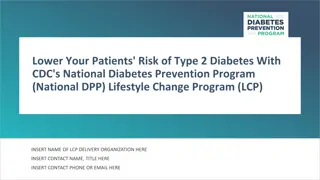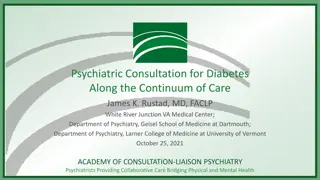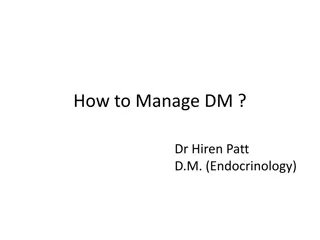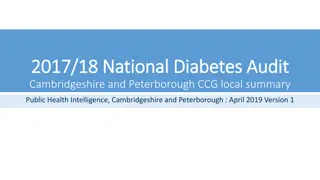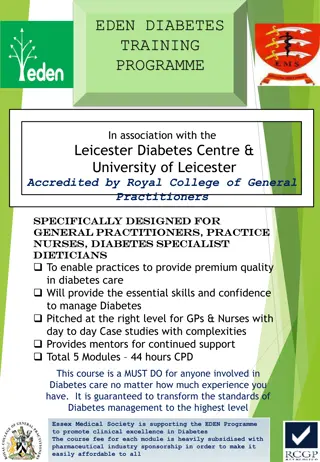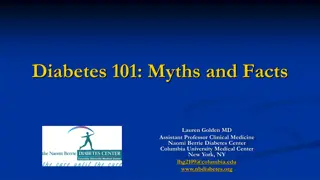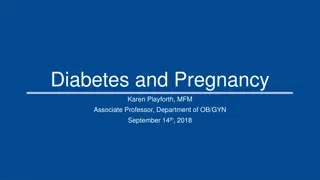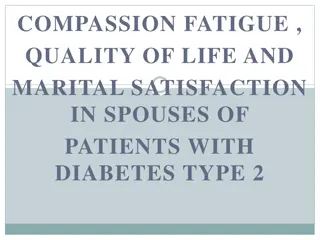
Elderly Patients Diabetes Management Capstone Proposal
Explore a capstone proposal focusing on managing diabetes in elderly patients using physical activity, diet practices, and community support. Evidence-based literature and objectives aim to improve diet, reduce diabetic symptoms, increase physical activity, and enhance health outcomes in elderly individuals.
Download Presentation

Please find below an Image/Link to download the presentation.
The content on the website is provided AS IS for your information and personal use only. It may not be sold, licensed, or shared on other websites without obtaining consent from the author. If you encounter any issues during the download, it is possible that the publisher has removed the file from their server.
You are allowed to download the files provided on this website for personal or commercial use, subject to the condition that they are used lawfully. All files are the property of their respective owners.
The content on the website is provided AS IS for your information and personal use only. It may not be sold, licensed, or shared on other websites without obtaining consent from the author.
E N D
Presentation Transcript
Elderly Patients Diabetes Management Capstone Proposal
Elderly Patients Diabetes Management Intervention Use of physical activity and adequate di et practice Nursing education, coordinating with p hysical therapy, dietician to personalize f ood plan Social worker involved in community for food and activity support
Elderly Patients Diabetes Management Evidence-Based Literature Taylor et al. (2016) - effect of social cog nitive theory in promoting a lifestyle cha nge, finds a positive relationship in copin g efficacy and managing type-2-diabetes Matthews et al. (2017) the engagement of physical activity consultation has a po sitive effect on promoting exercise to ma nage blood sugar levels among patients.
Elderly Patients Diabetes Management Evidence-Based Literature Mendes (2016) finds that diabetes is no t properly managed through lifestyle mo difications Barreira et al. (2018), find out that physi cal exercise is a key tool that is used in the control of glucose and lipid profile an d combined with nutrition programs, ther e is an increased success chance
Elderly Patients Diabetes Management Objectives 1) an expectation of improving diet pla 2) A reduction in the rate of reporting di abetic symptoms 3) an expected increase in the rate of p hysical activity 4) an expected improvement in finger bl ood stick result and HbA1c.
Elderly Patients Diabetes Management Resources Needed Physical activity guidelines Health.go v (2019) 2ndedition guidelines on physic al activity Dietary recommendations guidelines i ndividual-specific diet guidelines for indi viduals
Elderly Patients Diabetes Management Anticipated Outcomes First, improving the diet plans in the ho me care systems Second, there is an expected reduction in the rate of reporting of diabetes sympt oms and attacks Third, there is an expected increase in t he standard precautions that are undert aken to prevent diabetes
Elderly Patients Diabetes Management Anticipated Outcomes Fourth - increase rate of physical activit y engagement by elderly persons; impor tant strategy for healthy sustenance (La nghammer et al., 2018) Fifth, increase is expected in the efficie ncy of the home care setting in providing physical activity assistance and dietary n eeds to the elderly
Elderly Patients Diabetes Management Evaluating the Outcomes Process Evaluation Process evaluation is also useful where there are no accurate data to provide th e appropriate information on an ongoing process which can create flexibility in im plementation. Multiple evaluations
Elderly Patients Diabetes Management Evaluating the Outcomes Number of cases of diabetes attacks Average time per week elderly patients engage in physical activity The rate of adherence to designed meal plans to meet key dietary needs and manage diabetes
Elderly Patients Diabetes Management References Barreira, E., Novo, A., Vaz, J. A., Pereira, A. M. G. (2018). Dietary program and physical activity impact on biochemical markers in patients with type 2 diabetes: A systematic review. Atenci n Primaria, 50(10) : 590-610. https://www.sciencedirect.com/science/article/pii/S021265671730152X#! CDC. (Centers for Disease Control and Prevention). (2020). Types of Evaluation. https://www.cdc.gov/ std/Program/pupestd/Types%20of%20Evaluation.pdf Health.gov. (2019). Physical Activity Guidelines 2nd Edition. https://health.gov/sites/default/files/2019-0 9/Physical_Activity_Guidelines_2nd_edition.pdf Langhammer, B., Bergland, A., Rydwik, E. (2018). The Importance of Physical Activity Exercise among Older People. Biomed Research International. DOI: 10.1155/2018/7856823 Matthews, L., Kirk, A., McCallum, M., Mutrie, N., Gold, A., Keen, A. (2017). The feasibility of a physical activity intervention for adults within routine diabetes care: a process evaluation. Practical Diabetes, 34( 1), 7-12a. https://doi.org/10.1002/pdi.2069 Mendes, A. (2016). Importance of nutrition in the care of patients with diabetes. British Journal of Com munity Nursing, 21(4): 212. DOI: 10.12968/bjcn.2016.21.4.212 Taylor, L., Raine, K. D., Plotnikoff, R. C., Vallance, J. K., Sharma, A. M., Spence, J. C. (2016). Underst anding physical activity in individuals with prediabetes: an application of social cognitive theory. Psychol Health Med, 21(2): 254-260. DOI: 10.1080/13548506.2015.1058486 Wake, A. D. (2020). Antidiabetic Effects of Physical Activity: How It Helps to Control Type 2 Diabetes. Diabetes, Metabolic Syndrome and Obesity: Targets and Therapy, ume 13, 2909 2923.


